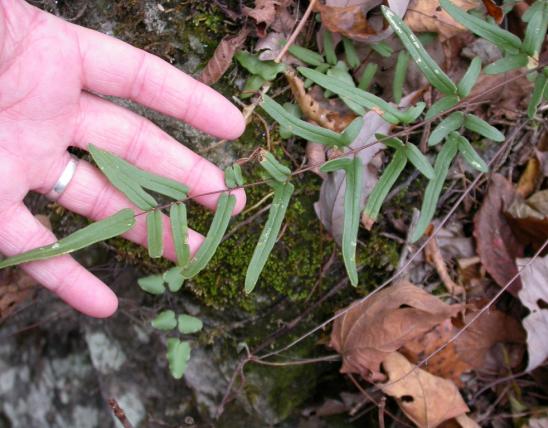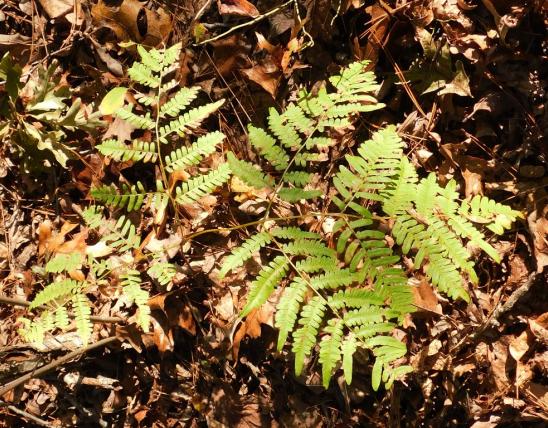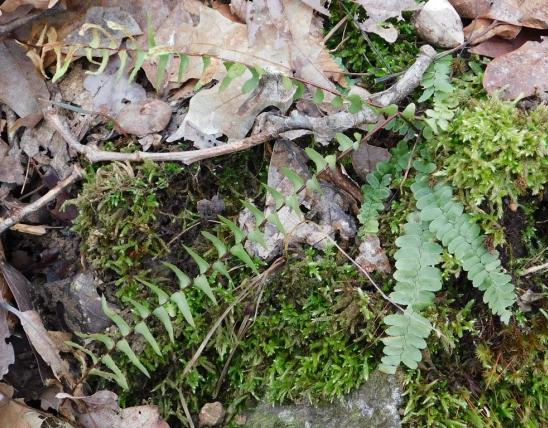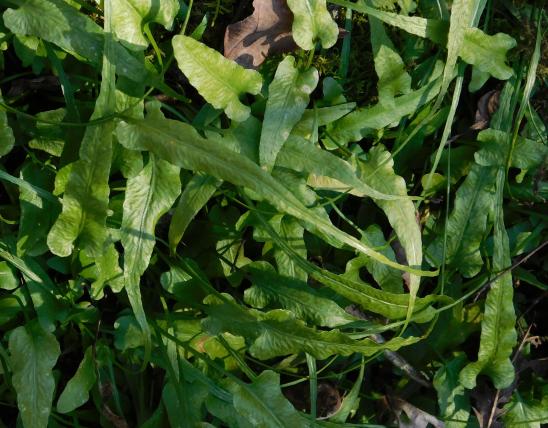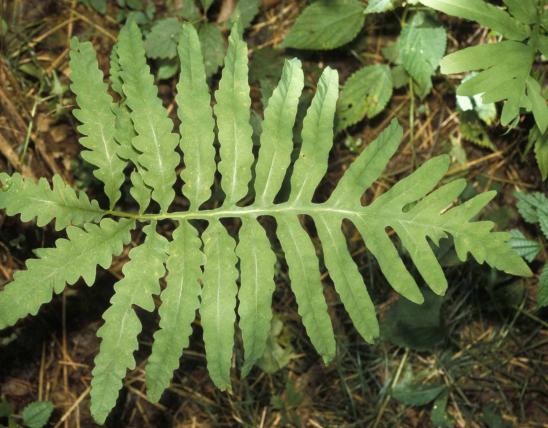
A perennial fern growing as a cluster of leaves from a rhizome, smooth cliff brake is almost always seen growing out of an exposed limestone or dolomite bluff or rock. The stiff, wiry stems are brown, hairless, or with a few scattered hairs. In general outline, the entire leaf (frond) is narrow, lance-shaped or oblong, and is once- or twice-compound. Leaflets can be leathery or not and sometimes have 1 or 2 lobes at the base. Leaflets are narrowly lanceolate to ovate or oblong, lacking hairs. Spores are borne on the undersides of the leaflets, in a continuous band along the outer margin, protected by the recurved edge of the leaflet. Spores are produced April–October.
Similar species: A close relative, purple cliff brake (P. atropurpurea) has somewhat dimorphic fronds: they take two different forms. Fertile fronds have spore-bearing leaflets, which are narrower and more divided, while the leaflets on sterile fronds are wider and more rounded. Also, the stems and midveins of purple cliff brake are densely hairy with short, curly hairs on the upper surface. It can be a larger plant: its leaves can be 20 inches long, and its leaflets can be 1½ inches in length. Also, it is more likely to be growing in soil.
Leaf length: 3 to 9 inches; leaflet length: ¼ to 1 inch.
Scattered throughout the Ozark and Ozark Border regions, and also occurs north, locally, to Andrew, Knox, and Lewis counties.
Habitat and Conservation
Occurs on crevices and ledges of limestone and dolomite bluffs, boulders, and rock outcrops, rarely on sandstone. Compared to the similar purple cliff brake, this fern is more strongly limited to exposed, rocky habitats and is less likely to be seen growing in soil.
Life Cycle
Ferns have a two-part life cycle. The plants we usually see are called sporophytes, because they produce spores that germinate and become the other part of the life cycle, the gametophytes. Gametophytes in this family of ferns are small, green, flat, kidney- or heart-shaped plants that few people notice. The gametophytes produce eggs and sperm, which unite to become a new sporophyte plant.
Cliff brakes, however, are famous for hybridizing with each other, and for creating offspring that are polyploid (possess more than two sets of genetic information in each cell), and for reproducing via apogamy. Apogamy is when a new sporophyte plant forms without fertilization — so it has the same number of genetic copies as the gametophyte.
Missouri has two varieties of smooth cliff brake: var. glabella reproduces via apogamy and has larger spores (it is tetraploid, possessing 4 sets of each gene); it is more common. Var. missouriensis reproduces sexually and has smaller spores (it is diploid, possessing 2 sets of each gene); it’s the ancestor of var. glabella and is limited to only a few counties. You can only tell these two varieties apart by using a microscope!
Human Connections
Why is it “brake” and not “break”? It is logical to think of these cliff-loving ferns as plants that ultimately help “break apart” the rock surfaces of bluffs, but the word brake, with Middle English and Scandinavian roots, actually means “fern.” This is why we don’t call these plants “cliff brake ferns.” For the same reason, there is a fern called “bracken” and not “bracken fern.”
Ecosystem Connections
Little information is available about the connections between smooth cliff brake and insects and other animals. As enduring plants of cliff, bluff, and other dry, rocky habitats, cliff brake surely provides cover for insects and spiders that live in those natural communities. And small birds can perch on these ferns to forage for the insects and spiders! Also, like other vegetation that grows in rock crevices, these ferns contribute to the weathering of rock faces.




























